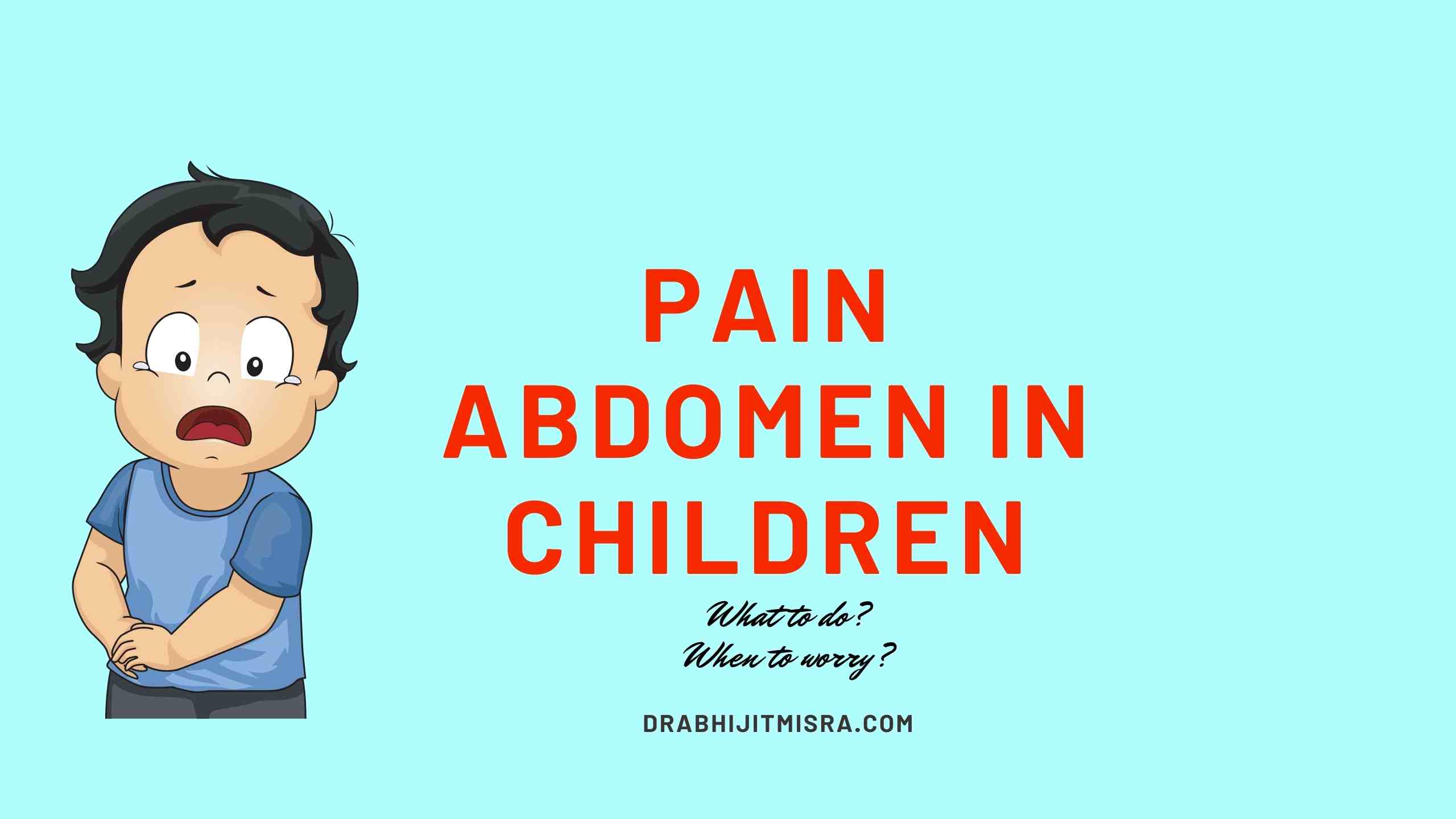
Pain abdomen is one of the familiar problems children face. Often, parents get very anxious and visit either an emergency or a doctor with this complaint. More commonly, abdominal pain is a recurrent symptom and is not associated with any physical disability or mortality.
To get quick relief, parents give various medicines starting from a digestive enzyme to anti-colic medications to herbal and ayurvedic remedies. Which might be harmful. Some drugs suppress the pain and underlying illness and therefore delaying the detection of the serious disease.
How common is pain abdomen in children?
Up to 28% of children complain of abdominal pain once a week, and 2% seek medical attention. Almost 20% of children seek medical attention for chronic abdominal pain by the age of 15 years.
Causes of pain abdomen: pain abdomen in children can be due to a minor problem like indigestion or flatulence, although sometimes it can be as serious as acute appendicitis or intestinal obstruction.
Causes of abdominal pain:
- Infection in the abdomen: like Gastritis, Enteritis, Appendicitis, Hepatitis, Pancreatitis, Peritonitis, Colitis, Urine infection, etc. They are usually associated with fever
- Infection outside abdomen: Pharyngitis and pneumonia are the 2 common pediatric infections that can present with severe acute pain abdomen
- Food intolerance: like cows’ milk, egg, nut, soyabean, colored foods, outside cooked foods
- Toxic substance ingestion: from toys, play dough, nail polish etc.
- Intestinal obstructions: need urgent surgical interventions
- Constipation
- Giardiasis, amoebiasis, worm infestation
- Others: gall bladder stone, renal stone etc.
Chronic or Recurrent abdominal pain: at least 3 episodes of pain over at least 3 months severe enough to affect the child’s normal daily activities.
Many a time pain abdomen in children do not have any anatomic abnormality or infection of the abdomen. They are called functional or non-organic abdominal pain.
ROME IV criteria of different types of functional abdominal pain
Functional dyspepsia
- Fullness after meals
- Early satiety
- Pain or burning in the upper abdomen not associated with defecation
- After proper evaluation, the symptoms cannot be fully explained by another medical condition.
Abdominal migraine
- Sudden attacks of intense, periumbilical, midline, or diffuse abdominal pain lasting 1 hour or more
- Episodes are separated by weeks to months
- The pain interferes with normal activities
- Stereotypical pattern and symptoms in a particular patient
- The pain is associated with 2 or more of the following
v Anorexia
v Nausea
v Vomiting
v Headache
v Photophobia
v Pallor
- After proper evaluation, the symptoms cannot be fully explained by another medical condition
Irritable Bowel Syndrome
- At least 4 days of Abdominal pain per month associated with one or more of the following:
v Related to defecation
v A change in frequency of stool
v A change in form (appearance) of stool
- If the child is constipated, the pain does not go with a resolution of constipation (children in whom the pain resolves have functional constipation, not irritable bowel syndrome)
- After proper evaluation, the symptoms cannot be fully explained by another medical condition
Abdominal Pain-NOS
- Sudden or continuous abdominal pain that does not occur solely during physiologic events (e.g., eating, menses)
- Irritable bowel syndrome, functional dyspepsia, or abdominal migraine criteria is not met.
- After proper evaluation, the abdominal pain cannot be fully explained by another medical condition.
When not to worry too much:
- Pain on and around the umbilical area and vague in character
- Pain not disturbing sleep
- Pain not associated with fever, vomiting, or altered stool habits
- The active and playful child
When to worry or seek medical attention, urgently (RED FLAG SYMPTOMS):
- A localized pain in other than the umbilical area
- Pain associated with fever, vomiting, or altered stool habits
- Pain abdomen with jaundice
- Pain abdomen with urinary discomfort
- Pain abdomen with significant abdominal distention
- Pain disturbing sleep
- Problem affecting normal daily activities of the child
- Chronic pain with weight loss
What parents need to do:
- Dietary modifications: If a new food (like a health drink or cow’s milk or nuts or soybeans, etc.. ) has been started in the diet, parents can avoid giving those things for few weeks and see the response. If the pain is due to food intolerance, it will decrease over the next few days after stoppage of the food.
- Avoid giving junk foods: like burgers, pizza, sweets, chocolates, chips, fries, etc.
- Give more water to drink.
- Give home-cooked, light foods in small amounts and more frequently.
- Clean hands: maintain a clean hand by:
- trimming nails regularly
- washing hands before feeding
- Avoid applying nail polish.
- Avoid nail-biting habits.
- Toilet training: ensure regular voiding of urine (3 to 4 hourly) and daily bowel movements. Put your child daily at a fixed time in the loo for at least 10 minutes, even if no urge is mentioned.
- Ensure normal physical activity: regular physical activities to be ensured. Spend more active playtime.
- Regular deworming after consultation with the pediatrician.
- Cognitive-behavioral therapy: especially for recurrent or functional abdominal pain after consulting a therapist.
- Medications: Don’t self medicate. As some medicines will suppress the pain, and therefore, underlying serious illnesses like appendicitis or abdominal infections will get masked temporarily to get worse later. Some OTC drugs like dicyclomine or paracetamol can be given after a doctor’s consultation.
TAKE HOME MESSAGE:
- Pain abdomen in children is common, and many a time it is recurrent or chronic.
- The majority of cases are harmless and do not need extensive treatment.
- A parent should look for the enlisted red flag symptoms to seek urgent medical attention.
- Parents should practice right hand and food hygiene to minimize the occurrence of the problem.
- Do not self-medicate; seek an expert advice when needed.

Leave a Reply